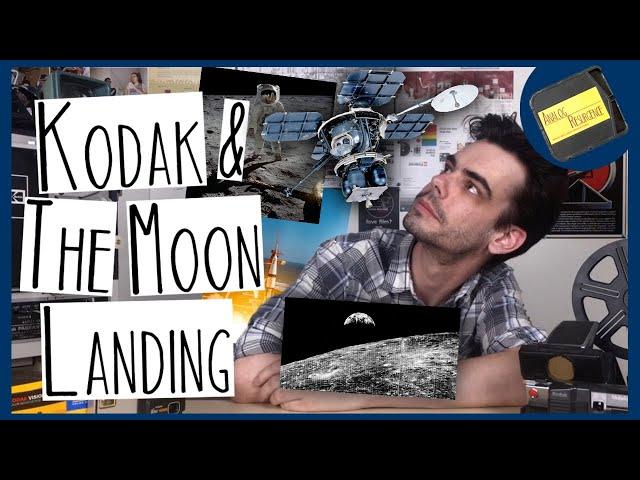
Kodak & The Moon Landing | The Ultimate Kodak Moment
Комментарии:

Pretty cool
Ответить
The speed at which those orbiters were travelling at when they hit the surface, there wouldn't be much left to salvage. Much of the orbiters would've been vaporised on impact. Or, busted up into tiny pieces and scattered all over the joint. That, and 50+ years of freeze-thawing would've turned the film into dust and the cameras, if any survived, into useless pieces of junk.
It's the same with those Hassies they left up there. All now useless.

I thought dis was bout kodak black
Ответить
As an engineer this stuff blows my mind, what they could accomplish back then.
Ответить
I've noticed Reconnaissance is one of those words that can identify if you're from the US or CA. Each country has a slightly different pronunciation.
Ответить
so they basically vectorized that image of the moon to send it to earth. Cool
Ответить
I wonder if they could have made like a box that could take the impact of the crash to store the negatives inside of, so they can recover them one day and have even higher quality images
Ответить
I have to wonder how a Canadian feels trying to explain something like this knowing the US did it and not Canada. Just wondering?
Ответить
Wow. The BiMat system seems remarkably similar to the way Polaroid's Polavision & PolaChrome/Pan/Graph "instant" 35mm slide film's processed their rolls.
Ответить
Wow. I had no idea. Fascinating. Thanks for sharing. My only disappointment is that I could have used this knowledge to complain to those early film labs who took way to long to process my film. "We can process film orbiting the moon but you can't get my birthday prints back by Tuesday?"
Ответить
what is the background track I hear with this thumping sound? lol
Ответить
Wow this was awesome! Always wondered how they did it
Ответить
Love this episode, thanks for sharing Noah !!!
Ответить
The Apollo astronauts also left 9 of 12 Hasselblad cameras on the surface of the moon to have enough room and weight capacity for moon rocks. Also, Alan Bean of Apollo 12 unintentionally left several magazines with exposed film on the surface (and he also destroyed a color TV camera by pointing it directly to the sun, lost an external self timer, he smuggled on board and was hit on the head by a 16mm camera when splashing down in the pacific ocean – you could say he had a special relationship with cameras on his mission).
Ответить
Your channel could do with a resurgence
Ответить
Hey i need help im geting a mupi mupletmatic projector and i need some info or video on it mine is the version with a motor not the crank one
Ответить
Wow, that's super cool
Ответить
I was totally unaware of that aspect of the lunar program, quite interesting
Ответить
Super interesting! So glad I found this vid.
Ответить
Great video
Ответить
So interesting thanks man!!!
Ответить
can you do a video on caffenol?
Ответить
Amazing video, I own TheCameraShop in New Zealand, we were a Kodak Express until 2012 and after 20 years I never heard that story, great vid.
Ответить
Amazing details with the video, love watching your channel.
Ответить
Bullshit! They never landed on the moon ! Wake up ppl we live in a closed system !! U can't go to the moon!
I love film but I don't believe this shit, I wish u can just do a little research !!

The Bimat system reminds me of the process Polaroid used for their 35mm PolaChrome (& PolaPan) "instant" slide film. Did Polaroid have any patent issues with the far earlier Kodak process? I for one would be curious to see the two systems compared.
Ответить
Also, don't forget the Hasselblads that were left on the moon in order to save weight in the lunar module. They were likely the world's most expensive disposable cameras.
Ответить
Such a cool story. They have one of the (spare) lunar orbiters on display at the Eastman House museum in Rochester.
Ответить
Also the Russians had a program before the lunar orbiter with flyby and crash landing probes that sent images before they crashed.
Famously one of them being killed midframe. These where not near the resolution of the Kodak images, but still the first images of the backside of the moon ever seen by man.

Brb. Going to the moon to thrift a camera
Ответить
Kubrick liked ektachrome :D
Ответить
I sometimes wonder if something like the bimat system would be viable for home development?
You are missing some fine points.
For instance: It’s not a high and low resolution lens. It’s a wide and tele lens.
The then publicly released photos where not anywhere near full quality, because they could have been used by the Soviet Union. The photos as received where much closer to the quality in the recovered ones.
The scanner was not “basically a bright light”. It was a flying spot scanner, not much unlike a drumscanner, sans drum.
They didn’t just crash every Lunar Orbiter when a new one went into orbit. They actually had a communications code to address the different orbiters. Sometimes when the batteries where low or the signal weak the wrong orbiter would respond. So at that point they decided to crash it.

Thanks Noah, great video! I've heard about the Hasselblads sitting on the moon, but not really about the Lunar orbiter program, interesting!
Ответить
I wish that somebody someday will find those lunars and the film inside.
.
.
.
.
.
(sorry if I make some mistakes my english isn't good)

Two of my favorite things, space and film
Ответить
This is so fascinating. My friend and I were actually wondering how images from satellites were transferred before digital sensors. I had theorized that they used a development process in the satellite itself and then broadcast it down somehow. I didn't even think about how dangerous it would be to use liquids in a satellite.
Ответить
Get yer Radioactive Hasselblads here! Fresh from the Moon, covered in righteous Moon dust, that was once worth a ton of money to Science! Crashed Hi-Rez photographic systems, only slightly damaged, also full of Moon dust! Long strips of processed film and ancient electronics for the discriminating collector. What is it worth to you?
Ответить
great video as always
Ответить
Awesome video as always!! 1 love your channel!!
Ответить

























